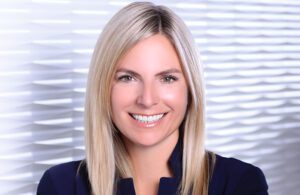
The ZimVie Tether system is FDA approved for adolescent idiopathic scoliosis under a humanitarian device exemption. [Image courtesy of ZimVie]
But for every patient the clock is ticking, as children are only eligible if they have enough growth ahead of them for the technology to make a difference. And all too often, insurance companies can delay the treatment so long that patients are no longer eligible if and when insurers approve the procedure.
ZimVie SVP and Global Spine President Rebecca Whitney spoke about the system’s development and commercialization with ZimVie Spine Global R&D Director Ryan Watson today at DeviceTalks Boston.

Rebecca Whitney is ZimVie’s global spine president. [Photo courtesy of ZimVie]
What is adolescent idiopathic scoliosis?
Adolescent idiopathic scoliosis is a curvature of the spine affecting 2-3% of the population. While diagnoses are evenly split between boys and girls, girls are eight times more likely to have curvature severe enough to require treatment.
“Idiopathic is basically code for ‘we don’t know.’ It’s not really clear as to why this happens, what creates the phenomenon,” Whitney said.
The condition can be lived with but causes issues as it progresses, including aesthetic issues and potentially life-threatening heart and lung compression. Traditional standards of care have had varying degrees of effectiveness.
“The first line of defense is a wait-and-see approach because a lot of times these curves don’t progress to the point where they do need intervention,” Whitney said. “If they do, bracing is usually the first order of treatment. Bracing can be effective, but the challenge with bracing is these kids are required to wear a brace from 12 to 20 hours a day.”
Bracing can range from uncomfortable to painful, and the biggest reason why it fails is because patients don’t want to wear them. If bracing doesn’t work, the historical standard of care is fusion.
“Posterior spinal fusion is very effective at straightening out the spine,” Whitney said. “It does that part very well, but it’s also very invasive. … You’ve got screws and rods placed all up and down the spine, and then you’re fusing that spine in place. It fixes the curvature of the spine, but it comes with long-term, potential limitations as the patient goes on to grow and continue with their active lifestyle.”
Vertebral body tethering for adolescent idiopathic scoliosis
A less-invasive alternative to fusing for adolescent idiopathic scoliosis is motion-preserving vertebral body tethering.
“Instead of fusing the back all up and down, you have these anchor points and you’re able to use basically a shoestring of sorts. And as the patient grows, that spine is able to straighten out without having to fuse the spine in place,” Whitney said. “We believe that for patients who are indicated, this is a really great solution and it offers the benefits of fusion while also preserving lifestyle. And for the most part, these kids are very active and looking to get back to a very healthy level of a lifestyle.”
The procedure entails putting screws into the convex (curved) side of the spine, coming in laterally through the side of the patient – through their ribs or over their spine — and then putting the cord between the screws.
“On the operating table, the surgeon [can] tension that cord and pull the spine straight,” Watson said. “Now, they don’t get all of the correction on the table, because this is kind of the beauty of this product and what we’re after. It’s called growth modulation.”
The surgeon might be able to achieve 50-80% of the curvature correction in the operating room. Beyond that, the tether helps hold the convex side of the spine and allows the other side to grow and straighten over time.
“It’s a pretty phenomenal way to take advantage of these patients’ own growth,” Watson said. “Diagnostic tools are used with X-ray for an assessment of how much growth those patients still have to ensure that they’re the right candidate, because this fantastic technology is not necessarily the solution for every patient with these conditions. But for those that have the right parameters, it is really pretty special.”
Developing the Tether system

ZimVie Spine Global R&D Director Ryan Watson [Photo courtesy of ZimVie]
“In 2013, we the company see this begin to take off and we say, ‘You know what? We want to participate in this. We want to help create this and make it more readily available to these patients,'” Watson said.
As Zimmer considered the time and cost of clinical trials to take the technology to market for adolescent idiopathic scoliosis, surgeons continued on their own based on the results they were seeing.
“In 2015, the FDA began to see this being more prevalent and said, ‘OK, you need to stop this usage.’ But fortunately, so much good data was collected by the early surgeons and the case was made. … They wanted to take part in making this available, so they showed up to the table, we worked with them and got a humanitarian use device designation,” Watson said.
Zimmer merged with Biomet in 2015. The FDA approved Zimmer Biomet’s Tether system under the humanitarian device exemption (HDE) pathway in 2019. It was the first approval of a humanitarian use device in spinal pediatrics in 15 years.
ZimVie — which spun out of Zimmer Biomet in 2022 — was the first company in the U.S. with HDE approval for vertebral body tethering to correct pediatric scoliosis. In 2019, ApiFix (now owned by OrthoPediatrics) received HDE approval for a rod-based growth modulation system. In May 2023, Globus Medical’s Reflect Scoliosis Correction System won HDE approval for progressive idiopathic scoliosis in pediatric patients.
The Tether system had shorter screws for smaller patients and other minor changes from Dynesys, but the team was careful not to change too much at the risk of invalidating the data surgeons generated and collected in early cases.
Machinists and test engineers prototyped 42 different instruments, 144 anchors and more than 400 screws over six months, Watson said. Then came computer simulations to test the concepts before cutting the metal, followed by testing 242 cords and conducting 281 mechanical tests on test frames. The team soon eclipsed 19,000 testing hours.
The ZimVie R&D team uses spine simulators that can put devices and systems through a series of motions. “I’ve got five or six machines running as we speak that are running around the clock,” Watson said.
He credited collaboration across the company and beyond for bringing the Tether system to market.
“It’s a tremendous amount of effort, testing and development that goes into this,” Watson said. “It’s not just the engineers, it’s the surgeons that had the vision partnering with the engineering team, the cross-functional members, and then the company that’s willing to do it.”
“This is a relatively small market and a lot of work,” Watson said. “We do it because it matters.”
Getting ZimVie’s Tether to more patients
Only one in 10 children who are indicated for the Tether system are treated with it, Whitney said. “It’s relatively new and like any adoption life cycle curve, we’re in that early stage.”
ZimVie is striving to increase adoption with surgeon training, patient awareness, and pushing through insurance barriers.
The company has an eight-station cadaver training facility in Colorado for surgeons, and also connects them with leaders in the field. To reach patients, the company funds marketing aimed at parents including a website, myscoliosis.com, and promotes Facebook groups with resources for patients and parents.
“We don’t want to bias any of that conversation, but we do support their efforts because we know that it can be a really challenging time when you have a child who was diagnosed and you’re trying to seek out all the different information that’s out there,” Whitney said.
On the insurance side, ZimVie is constantly lobbying insurers to cover the procedure.
“We had a big win last summer when Anthem Blue Cross Blue Shield deemed the Tether as medically necessary. And we think that would be the first domino to follow, which is really encouraging,” she said. “But the reality is a lot of these kids get stuck in this constant denial and approval process with the insurers.”
That can often delay care, sometimes long enough that children have grown too much in the meantime for the system to help. But ZimVie is on track to receive a Category 1 Current Procedural Terminology code in January 2024 to significantly increase access for patients.
“Developing a market is a long game and takes commitment and a lot of resources and investment. We’re doing it because we firmly believe it’s the right thing to do,” Whitney said. “As we continue to develop this and we see more and more kids receiving access, it is the fuel and the passion that keeps all of us continuing to march forward.”
This story was originally published on May 10, 2023, and updated on May 16 when the FDA approved the Globus Medical REFLECT Scoliosis Correction System.




